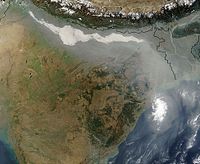
Photo from wikipedia
In the present work, the soil gas radon survey has been carried out for locating the trend of soil radon in the foothills of Siwalik which is covered with lithology… Click to show full abstract
In the present work, the soil gas radon survey has been carried out for locating the trend of soil radon in the foothills of Siwalik which is covered with lithology of Pliocene unconsolidated deposits. Soil gas radon concentration and mass exhalation rate have been studied in natural soil samples of Udhampur district, Jammu and Kashmir, India using active measurement technique RAD7 and smart RnDuo monitor. The sampling measurements were chosen according to suitability of the area. Few of the locations are near the Main Boundary Thrust (MBT) and tectonically active lineaments, having reasonably high concentration of soil gas radon. The soil gas radon concentration in 15 locations of studied area has been measured at different depths (30, 45 and 60 cm) and the overall soil gas concentration was found to vary from 0.14 to 61.01 kBq m−3, respectively. This large variation in radon content might be due to radioactive nature of the bedrocks present in different geological structure. Soil pore diffusion model have been used to observe the relation between experimentally and theoretically determined soil gas radon concentrations in the studied region.
Journal Title: Pure and Applied Geophysics
Year Published: 2018
Link to full text (if available)
Share on Social Media: Sign Up to like & get
recommendations!